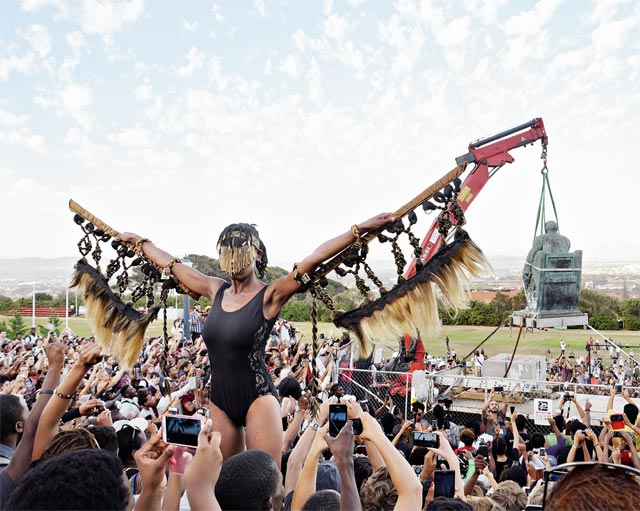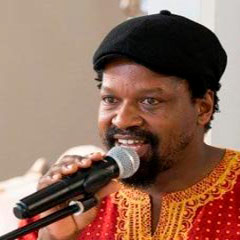In this chapter, I trace the original source of the image that inspired the artwork by Sethembile Msezane titled, ‘Chapungu- The Day Rhodes Fell (2015). I envision that to get to the bottom of it, the etymology of the word ‘chapungu’ as used in the title of the artwork will have to be retraced and given context. The second section of the chapter discusses the content of the artwork in relation to how it endeavors to employ the old classical imagery in an attempt to negotiate new meanings. Lastly, borrowing from a family of critical discourse analysis theories (Fairclough and Wodak 1997; van Dijk 1997; Wodak 2001b) the strategies of monumentalisation as constructed by the dominant political culture will be analysed.
What is in the title? The etymology of the word ‘chapungu’.
The word chapungu is associated with a language used by the Shona people found in Zimbabwe. The Shona language developed as part of the greater Bantu heritage populating the central and southern Africa. According to the online VaShona project dictionary, the word chapungu refers to: “Any large, rapacious bird of the Falcon family, esp. of the general Aquila and Haliaeetus. The eagle is remarkable for strength, size, graceful figure, keenness of vision, and extraordinary flight” (https://vashona.com/en/dictionary/sna/chapungu). The Shona tribe of Zimbabwe created myths about the chipungu bird. Some elements of those myths seem to have been inspired by other world’s mythologies of birds with mythical powers. In the beliefs of the Shona, “the bird called chapungu (bateleur eagle) is a good omen, bringing protection and good fortune to a community” (Muzari 2013:1). The chapungu bird is also seen as a symbol of strength hope and renewal. The attributes used by the Shona people to describe the myths and beliefs about the chapungu bird seem to flow into the metaphor of a phoenix bird. Accordingly, I maintain that the context is key in recapturing the derivation of meaning behind the title of Msezane’s artwork. Shedding light on the etymology of the word ‘chapungu’ brings us to appreciate the connection between Cecil John Rhodes and the Shona people of Zimbabwe. Of course, to assume that the title ‘Chapungu - The Day Rhodes Fell’ (2015) is not connected to Cecil John Rhodes might be too farfetched. Evidence drawn from history shows that there is a direct relationship between Rhodes and Zimbabwe (formerly known as Rhodesia). Moreover, when you ask the Shona people where does the word Zimbabwe originate from, they will inform you that it is a Shona word for ‘Stone houses’. Stone houses are a “historical stone structure known as Great Zimbabwe, which is the second largest in Africa after the Egyptian pyramids” (https://www.sahistory.org.za/article/role-cecil-john-rhodes-british-south-african-company-conquest-matabeleland). Cecil John Rhodes and the British South African Company (BSAC) invaded Zimbabwe in 1890. After the invasion, the lands were named the Southern and Northern Rhodesia, to honour Cecil John Rhodes (https://www.sahistory.org.za/people/cecil-john-rhodes). This connection enlightens us in terms of what might have probed the artist to use the Shona word, ‘Chapungu’ as part of a title of her work.
Old image new meanings
The foreground of the artwork depicts an image of the artist spreading her arms far wide projecting a takeoff position. It is known knowledge that humans will never fly by flapping arms with wings. Therefore, this self-defining act transforms her incapable human physicality into a metaphysical creature that is capable and ready to fly. The act by this metaphysical creature can also be received as its yearning for freedom and justice. Moreover, it also becomes a creature that is able to defy and transcends time and space. In her artists statement Msezane (2016) concedes that “she employs strategies of creating self-definition that are deeply rooted in looking at her own past, be it through spirituality or relearning South African history and its alternate narratives” (Msezane 2016). The image of this creature is strategically deployed for the audience to perhaps liken its agency to that of a myth of the phoenix rising from the ashes.
Associated with the temple of the Sun in Egypt, and re-invented in Greek mythology, the story of the phoenix has been appraised as one of the world’s most-loved stories. It is the mythology of the world of modern monsters as told and retold by writers, philosophers, artists and poets through generations. Tacitus and Ovid are the two great authors from the classical period who stand out when painting a picture of the phoenix mythology. Perhaps it is mostly because of the way that Tacitus ventures out to humanise the attributes and actions of the phoenix and he refers to it as ‘he/him’. While, Ovid negates the phoenix of subject pronouns which are only used when referring to people. In telling his story, Ovid refers to the phoenix as ‘it’.
Tacitus narrated the story in the following detail, “in the consulship of Paulus Fabius (A.D. 34) the miraculous bird known to the world by the name of the Phoenix, after disappearing for a series of ages, revisited Egypt. It was attended in its flight by a group of various birds, all attracted by the novelty, and gazing with wonder at so beautiful an appearance. The first care of the young bird as soon as fledged, and able to trust to his wings, is to perform the obsequies of his father. However, this duty is not undertaken rashly. He collects a quantity of myrrh, and to try his strength makes frequent excursions with a load on his back. When he has gained sufficient confidence in his own vigour, he takes up the body of his father and flies with it to the altar of the Sun, where he leaves it to be consumed in flames of fragrance” (Bulfinch 19AD:[sp]).
Ovid’s story is almost similar the one told by Tacitus. Ovid’s version is narrated as follows: “Most beings spring from other individuals; but there is a certain kind which reproduces itself. The Assyrians call it the Phoenix. It does not live on fruit or flowers, but on frankincense and odoriferous gums. When it has lived five hundred years, it builds itself a nest in the branches of an oak, or on the top of a palm tree. In this it collects cinnamon, and spikenard, and myrrh, and of these ‘materials builds a pile on which it deposits itself, and dying, breathes out its last breath amidst odours. From the body of the parent bird, a young Phoenix issues forth, destined to live as long as its predecessor. When this has grown up and gained sufficient strength, it lifts its nest from the tree (its own cradle and its parent’s sepulchre), and carries it to the city of Heliopolis in Egypt, and deposits it in the temple of the Sun” (Bulfinch 19AD:[sp]). To this end, Msezane’s (2015) artwork references a known classical image of the phoenix to negotiate her struggle to recover her lost forms of visibility as a black woman in South Africa. In this way, it can be said that she is born again. Msezane (2016) is quoted as expressing that, “by examining past and present representations of black women…, in public and private domains, [she] focuses on the omission of iconic black women in history and mythology” (Gallery Momo 2016:[sp]).
At the background, the stage of the statue of ‘Rhodes falling’ is set. The site is loaded with the ambience of euphoria, yet almost similar to the scene of tragedy; it also gives you a baffling feeling of trepidation. A sense of uneasiness perhaps also emanates from an inferred ever presence of violence. Intended or imagined, the violence is visibly signaled by a force of a crane removing the statue. To anyone with eyes and curiosity, the crane’s arm also propounds an idea of a machine-gun. Unlike Camus’ (1942) existential theatre of the absurd, this background theatre in Msezane’s artwork seems to seal the fate of Rhodes, as if ‘he’ was going to be destroyed either way. Either by the truck that is physically depicted removing ‘him’ to a point of obscurity or by the machine gun.
Monuments and dominant political power
In concluding notes, monuments form part of a critical discourse in the legitimisation of a dominant political power structure. The public installation of powerful elites as iconic figures is either a precursor or descendant of the formulation of a nation. Either way, monuments and monumentalisation are a political construct that is trapped within the discourse of inclusion and exclusion. In response to this dilemma, Msezane’s artwork (2015) deploys a struggle to affirm the existence of the excluded in the formulation the powerful symbols for the nation. Most of all, her work challenges the percieved role of national symbols and commemoration spaces as key features in the portrayal of women as invisible subjects in history. As a young women growing up in Cape Town South Africa, Msezane looked around and saw no reflection of herself represented in public space such as the statues and monuments. Her performance piece where her female black body stands upright holding her wings straight out to the sides as if a phoenix rising from the ashes is indeed an act of self-affirmation. Msezane asks for no permissions but use the re-imaging as a strategy to re-insect her female black body as evidence of her existence.
Bibliography
- Birch, D. 2009: The Oxford Companion to English Literature (7 ed.) The Theatre of the Absurd (1942). Oxford University Press.
- Bulfinch, T. 2019: AD Bulfinch’s mythology: the age of fable: the age of chivalry: legends of Charlemagne. New York: Modern Library.
- Fairclough, N. and Wodak, R. 1997: Critical discourse analysis, in T. van Dijk (ed.), Discourse Studies: A Multidisciplinary Introduction. Vol. 2. London: Sage, pp. 258–84.
- http://www.krugerpark.co.za/africa_bateleur_eagle.html (Accessed 20 January 2019).
- https://www.sahistory.org.za/article/role-cecil-john-rhodes-british-south-african-company-conquest-matabeleland (Accessed 19 January 2019).
- https://www.sahistory.org.za/people/cecil-john-rhodes (Accessed 19 January 2019).
- http://www.unwomen.org/en/news/in-focus/women-and-the-sdgs (Accessed 23 January 2019).
- https://vashona.com/en/dictionary/sna/chapungu (Accessed 20 January 2019).
- Msezane, S. 2016: Artist statement. Gallery Momo, Johannesburg.
- Msezane, S. 2017: Kwasuka Sukela: Re-imagined Bodies of a (South African) 90s Born Woman. Exhibition catalogue 2017, Gallery Momo, Cape Town
- Muzari, G. 2013: When a luck-bringing bird falters. The Standard News. Zimbabwe.
- van Dijk, T. (ed.) 1997: Discourse Studies: A Multidisciplinary Introduction. 2 Vols. London: Sage.
- Wodak, R. 2001: What CDA is about — a summary of its history, important concepts and its developments, in R. Wodak and M. Meyer (eds), Methods of Critical Discourse Analysis. London: Sage, pp. 1–13.
published November 2019



